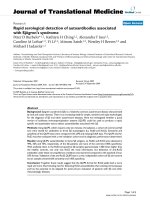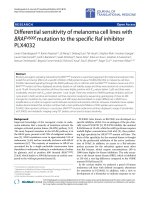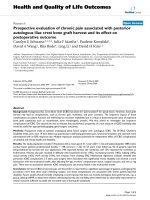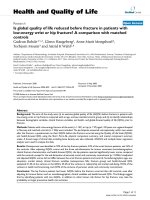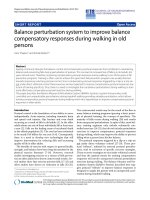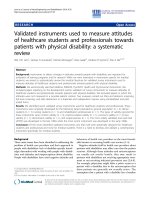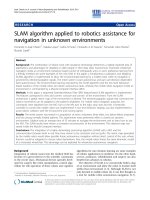Báo cáo hóa học: "Is occupational exposure to solvents associated with an increased risk for developing systemic scleroderma?" doc
Bạn đang xem bản rút gọn của tài liệu. Xem và tải ngay bản đầy đủ của tài liệu tại đây (223.41 KB, 6 trang )
BioMed Central
Page 1 of 6
(page number not for citation purposes)
Journal of Occupational Medicine
and Toxicology
Open Access
Research
Is occupational exposure to solvents associated with an increased
risk for developing systemic scleroderma?
Birgitta Kütting*
1
, Wolfgang Uter
2
and Hans Drexler
1
Address:
1
Institute and outpatient clinic of occupational, social and environmental medicine (head: Prof. Dr. H. Drexler), University of Erlangen-
Nuremberg, Schillerstr. 25 + 29, D-91054 Erlangen, Germany and
2
Dept. of Medical Informatics, Biometry and Epidemiology (head: Prof. Dr. O.
Gefeller), University of Erlangen-Nuremberg, Waldstr. 6, D-91054 Erlangen, Germany
Email: Birgitta Kütting* - ; Wolfgang Uter - ;
Hans Drexler -
* Corresponding author
Abstract
Background: Our study was aimed to investigate in a German collective if there are any hints for
an increased occupational or environmental risk to develop systemic sclerosis, especially, focussing
on work-related exposure to solvents. Moreover, we tried to evaluate the feasibility of a sampling
method addressing support groups.
Methods: A standardised questionnaire was published in two journals subscribed by members of
two different support groups and all members were asked to complete the questionnaire and to
return it anonymously. The subjects were not informed on the scientific hypotheses, nor did they
know who of them belonged to the case group (scleroderma) or to the control group (multiple
sclerosis).
Results: 175 questionnaires could be included in the statistical analysis. As expected, a female
predominance was in our collective. In the male subpopulation, the occupational exposure to
solvents was higher in the case group than in the control-group (70% versus 45.8%).
Based only on the male subgroup, a tendency for an association between occupational exposure to
solvents and the risk to develop systemic sclerosis was found.
Conclusion: According to our experience in this case-control-study exposure misclassification,
qualitative or quantitative, was an eminent problem. Within such a setting, it is generally very
difficult to establish an exact dose-response relationship due to incomplete, imprecise or missing
data concerning duration of exposure, frequency of use and kind of solvent. Additionally, a well-
known problem in studies based on self-reported questionnaires is the so-called volunteer bias.
Unfortunately, but similar to other studies assessing epidemiologic factors in such a rare disease,
our study was of limited power, especially in the subgroups defined by gender.
Background
Systemic sclerosis is a rare multisystem disease with a
reported incidence of 2 to 12 cases per million people per
year [1]. The disease is characterized by microvascular
alteration and massive deposition of collagen affecting
connective tissue in many parts of the body, especially
Published: 03 July 2006
Journal of Occupational Medicine and Toxicology 2006, 1:15 doi:10.1186/1745-6673-1-15
Received: 19 December 2005
Accepted: 03 July 2006
This article is available from: />© 2006 Kütting et al; licensee BioMed Central Ltd.
This is an Open Access article distributed under the terms of the Creative Commons Attribution License ( />),
which permits unrestricted use, distribution, and reproduction in any medium, provided the original work is properly cited.
Journal of Occupational Medicine and Toxicology 2006, 1:15 />Page 2 of 6
(page number not for citation purposes)
skin, oesophagus, lungs, gastrointestinal tract, kidney,
heart and other internal organs [2]. The aetiology of sys-
temic sclerosis still remains unclear. Data of epidemiolog-
ical studies suggest a complex interaction of genetic,
hormonal and environmental factors in the pathogenesis
of fibrotic changes in scleroderma [3]. Twin studies have
shown that the occurrence of systemic sclerosis in
monozygotic twins is rare suggesting a lesser role for
genetics [4,5]. In addition, familial clustering has not
been found [6]. Environmental factors may play a more
important role in the pathogenesis of systemic sclero-
derma. For instance, spouses of affected individuals have
an increased occurrence of autoantibodies, suggesting a
shared environmental exposure [7]. Ethnic susceptibility
has been demonstrated in Thai patients, who have a
higher incidence of anticentromer antibodies, and who
are more likely to have diffuse disease compared with
Caucasians and Australians [8]. Although hormones are
supposed to play a role in the aetiology of the disease in
women, a case control study failed to indicate an associa-
tion between systemic sclerosis and contraceptive use, ear-
lier age of menarche, or ever being pregnant [9].
A number of drugs have been reported to be associated
with the development of scleroderma-like disease, includ-
ing bleomycin, pentazocine, cocaine, appetite suppres-
sants and D-penicillamine [10].
Up to now, several work-related factors such as exposure
to silica dust, epoxy resins, organic solvents or work-
related hand-arm vibrations had been identified as impor-
tant risk factors for developing scleroderma [1,3]. In fact,
almost 50 years ago Reinl [11] was the first to point out
the association between systemic sclerosis and exposure
to solvents.
Since then several case reports and series [12-17] as well as
epidemiologic studies [18-21] have found systemic sclero-
sis to be positively associated with exposure to solvents.
Supportive of a causal association, a biologically plausible
link between organic solvent exposure and systemic scle-
rosis had been hypothesized: Organic solvents and their
reactive metabolites are supposed to bind covalently to
protein molecules such as topoisomerase I (Scl-70) and
may stimulate an autoimmune response [6].
Our study was aimed to investigate the relationship
between certain environmental or occupational exposures
and systemic scleroderma in a German population,
hereby focussing on the exposure to solvents.
At the same time, we critically evaluated the chosen
approach of accessing the study population.
Methods
A standardized questionnaire was published in two jour-
nals subscribed by members of two different self-help
associations and all members were asked to complete the
questionnaire and to return it anonymously to us. One of
the journals was the official organ of a self-help group for
patients suffering from scleroderma (cases), whereas the
other journal was subscribed by members of a multiple
sclerosis support group (control-group).
As control group, patients suffering from multiple sclero-
sis were selected, because similar to systemic sclerosis, the
aetiology is almost unknown and hence the administra-
tion of a questionnaire addressing a variety of potential
risk factors to this group appeared credible. Moreover, in
both diseases female patients predominate, offering the
chance of some degree of matching for this variable. The
subjects were not informed on our working hypotheses,
nor did they know who of them belonged to the case
group or to the control group. The questionnaire con-
sisted of 24 items, including some irrelevant questions, to
camouflage the exposures of interest. The first part of the
questionnaire consisted of questions concerning general
anamnestic data such as sex, date of birth, date of diagno-
sis and the parents' country of origin. The second part of
the questionnaire was focussed on professional activities
and exposure to harmful substances such as solvents,
metallic fumes, dust and hazardous working conditions
such as hand-arm vibration. If the questions were
answered in the affirmative we asked for the duration of
exposure during the working-life, frequency of exposure
and average time of exposure. The last part of the ques-
tionnaire asked for the intake of drugs inducing sclero-
derma-like disease, silicone gel-filled implants, infections,
private exposure to solvents and diet. The number of cop-
ies of both journals was 2000 each. The scleroderma sup-
port group was supposed to have approximately 1500
members; of these nearly 900 were known to suffer from
a systemic form of this disease. Only persons suffering
from systemic sclerosis were asked to complete the ques-
tionnaire. Potential confounders such as age, sex and race
were considered, in that analysis of the association
between exposures and case status were adjusted for age
(as median dichotomized categorical variable) and strati-
fied for sex in logistic regression analysis, and only Cauca-
sians were included in the analysis.
Sample
175 questionnaires could be included in the statistical
analysis. 109 questionnaires were returned by members of
the scleroderma self-help group, leading to a response rate
of 7.3%, based on the total number of members. Related
to the number of persons suffering from a systemic form
of the disease and these subjects were only asked to com-
plete our questionnaire, the response rate was 12.1%. In
Journal of Occupational Medicine and Toxicology 2006, 1:15 />Page 3 of 6
(page number not for citation purposes)
contrast, we received only 66 questionnaires from persons
suffering from multiple sclerosis. As expected, we had a
female predominance in our collective (especially in the
case group). In the case group, 99 women and 10 men
completed and returned the questionnaire, whereas in the
control group data of 42 women and 24 men could be
included in the analysis (p < 0.0001, Fisher's exact test).
Results
The mean age of persons suffering from scleroderma was
57 years (median 59 years, range 20 to 79 years). The aver-
age age of the female study population was 58 years,
whereas the men were 49 years old. The mean age of per-
sons suffering from multiple sclerosis was 45 years
(median 43 years, minimum 26 years, and maximum 75
years), i. e, somewhat younger. The women of the control
group were on average 43 years old, the men 47 years. All
subjects were Caucasian.
The female study population had been aware of the diag-
nosis of systemic sclerosis for 10 months, averaged (min-
imum 1 month, maximum 31 months, standard error
7.6), whereas the male study population reported on
knowing their diagnosis for 8 months at average (mini-
mum: 1 month, maximum 23 months, standard error
6.9). In the control group the duration of diagnosis was
indicated with almost 1 year on average (minimum 1
month, maximum 36 month, deviation 8.8) in the female
subgroup, the averaged indicated duration of diagnosis
had been almost ten month in the male subgroup. There-
fore, the mean duration of diagnosis was stated with 10
months in the study population versus 11 months in the
control group. The higher frequency of occupational and
private exposure to solvents in the control-group goes
along with a higher percentage of men (33% men in the
control group versus 9.2% in the study group). In the con-
trol-group, 33.3% (n = 22) reported work-related expo-
sure to solvents, whereas 56.1% (n = 37) indicated an
exposure to solvents due to private activities. However, in
the female subpopulation, the occupational exposure to
solvents was higher in the control-group (26.2%) com-
pared to the case group (12.1%). In the male subpopula-
tion the occupational exposure to solvents was higher in
the case group than in the control-group (70% versus
45.8%). The indicated frequency of occupational expo-
sure to solvents was the highest in the male study popula-
tion, 4 study participants indicated occupational
exposures to solvents more than four times a week (table
1). The female study population reported on 2 years and
1 month averaged occupational exposure to solvents,
whereas the male study population indicated a mean of
almost 12 and a half years (versus female control group:
3.2 years, male control group 4.3 years). Exposure to sol-
vents due to private activities such as renovation was
reported in 40.4% of all cases in the study group com-
pared to 56.1%, in the control-group. 10% of all cases of
scleroderma (7 women, 3 men) indicated as well occupa-
tional as private exposure to solvents, whereas 22.7%
Table 1: Frequency of occupational exposure to solvents
Frequency Cases female (n/%) Controls female (n/%) Cases male (n/%) Controls male (n/%)
missing data 0 1 0 1
0% 2.4% 0% 4.2%
never 85 31 3 13
85.9% 73.8% 30% 54.2%
2x/6 months 0 0 0 2
0% 0% 0% 8.3%
2x/3 months 0 0 0 1
0% 0% 0% 4.2%
1x/month 2 0 0 2
2% 0% 0% 8.3%
1x/week0021
0% 0% 20% 4.2%
2x/week0110
0% 2,4 10% 0%
3x/week1002
1% 0% 0% 8.3%
4x/week0010
0% 0% 10% 0%
5x/week6521
6.1% 11,9% 20% 4.2%
6x/week3210
3% 4,8% 10% 0%
daily 0 2 0 1
0% 4,8% 0% 4.2%
Journal of Occupational Medicine and Toxicology 2006, 1:15 />Page 4 of 6
(page number not for citation purposes)
reported this in the control group (5 women, 10 men)
(table 2).
Logistic regression analysis was performed, adjusting for
age (median dichotomized) and stratified for gender, to
derive gender-specific risk estimates. Due to the limited
size of the sample, exposure to solvents, occupational
hand-arm vibration and occupational exposure to metal-
lic dusts and fumes were considered in three different
logistic regression models. The results indicate that expo-
sure to solvents – whether occupationally related or pri-
vate – is generally not a risk factor for systemic
scleroderma; only in the subgroup of males a trend for
increased risk can be noted. Conversely, occupational
hand-arm vibration is associated with an increased risk,
much lesser so also occupational exposure to metallic
fumes. Model fit, as assessed with the Hosmer and Leme-
show test, was good to excellent in all cases (Tab. 2).
Discussion
In our study population a general positive association
between exposure to solvents and systemic scleroderma
could not be confirmed. Only in the male subgroup a
weak [non-significant] association between occupational
exposure to solvents and the risk of having systemic scle-
rosis was observed. Unfortunately, but similar to other
studies in this field, our study was of limited power, espe-
cially in the subgroups defined by gender.
A meta-analysis published three years ago by Aryal et al.
[18] confirmed a significant positive association between
exposure to solvents and systemic sclerosis. This meta-
analysis was based on 7 case-control-studies and one
cohort study, the number of cases varying between 21 and
274 cases. However, due to limited presentation of sub-
group data, the authors were unable to perform separate
meta-analyses for male and female subjects. It was sup-
posed that most of the studies included had a greater
number of female cases, reflecting the female predomi-
nance of this disease. Among the studies included in the
analysis, all but one [22] showed an association between
systemic sclerosis and solvents. The so-called publication
bias, a phenomenon of selective submission or accept-
ance of research based on the attainment of statistically
significant positive correlation, is probably responsible
for the preponderance of studies reporting an association
between exposure to solvents and the risk to develop sys-
temic sclerosis. However, the only study with the missing
association was performed in a strictly male study popu-
lation (number of cases n = 56). Recently, controversial to
the findings of Silman and Jones [22], a tendency for an
association between occupational exposure to solvents
and scleroderma had been observed only in male subjects
Table 2: Possible risk for developing scleroderma related on known occupational risk factors, quantified with the odds ratio (OR) as
derived from three separate logistic regression analyses, adjusted for age (<than overall median versus> = overall median).
Females (n = 141) Males (n = 34)
Cases (n =
99) n/%
Controls (n
= 42) n/%
OR [95%
CI]
GOF Cases (n =
10) n
Controls (n
= 24) n
OR [95%
CI]
GOF
Exposure to
solvents:
0.5768 0.8722
None 53 (53.5%) 17 (40.5%) 1.00
(reference)
2 6 1.00
(reference)
Private
only
31 (31.3%) 13 (31.0%) 1.047 (0.397–
2.815)
1 7 0.427 (0.017–
5.618)
Occupatio
nal only
5 (5.1%) 4 (9.5%) 0.480 (0.086–
2.644)
3 2 4.794 (0.459–
69.901)
Both 6 (6.1%)
#
5 (11.9%)
#
0.439 (0.089–
2.094)
4 9 0.427 (0.017–
5.618)
Occupational
hand-arm
vibration (any
vs. none)
5 (5.1%) 1 (2.4%) 2.961 (0.358–
62.605)
0.8970 4 6 2.050 (0.378–
11.312)
0.5780
Occupational
exposure to
metallic fumes
or dust (any
vs. none)
8 (8.1%) 4 (9.2%) 1.445 (0.366–
6.309)
0.8398 7 10 3.319 (0.708–
19.193)
0.8832
GOF: goodness of fit (p value of Hosmer and Lemeshow test)
#
remainder: missing
Journal of Occupational Medicine and Toxicology 2006, 1:15 />Page 5 of 6
(page number not for citation purposes)
[21]. The data of Bovenzi are very well in line with our
findings, even if both male subpopulations, due to the
female predominance of this disease, were very small with
9 [21] and 10 subjects, respectively.
Apart from publication bias, different types of bias may
limit the findings of such a case-control-study. Age, gen-
der and race are considered to be potential confounders of
systemic sclerosis, but these confounders have not always
been taken into account. Furthermore, due to the rarity of
the disease; it might be difficult – due to logistic reasons –
to include a large number of subjects. Therefore, most
studies are based on a small number of subjects, with cor-
respondingly imprecise effect estimates. Usually it might
be extremely difficult to recruit the control-group and to
convince the control subjects to take part in the trial. Addi-
tionally, there might be a huge difference between cases
and controls in the attitude of answering the question-
naire. To lessen or avoid this bias we decided to include
only patients (as cases and controls), who, from their per-
spective, might all have acted as case group, but not
informing the participants who of them belonged to the
case-group and who became part of the control-group.
However, as some of the evidence concerning an aetiolog-
ical role of solvents may have transpired to the systemic
sclerosis self-help association's members, but presumably
not to the MS group, we cannot rule out recall bias com-
pletely.
A well-known problem in studies based on self-reported
questionnaires is the so-called volunteer bias, a special
variant of selection bias. This bias implies that (i) the
overall response rate strongly depends how far subjects
feel addressed by the questions and suppose these ques-
tions to be relevant to reflect their personal situation and
(ii) those subjects who consider (some of) the exposures
of interest as relevant for their illness may selectively
respond. Therefore, we tried to develop a diversified ques-
tionnaire related to different topics. All work-related ques-
tions were embedded and mixed up with questions
concerning the past medical history, life style and nutri-
tion in order to camouflage our special interest in occupa-
tional exposure to solvents. Assuming that "housewives",
unemployed or retired subjects probably would not see
the necessity to answer work-related questions; we did our
best to mask our hypothesis as much as possible.
Although we were unable to employ the clear inclusion
criteria and a face-to-face examination for case ascertain-
ment often used in a case control study with the study
design chosen, and hence some degree of misclassifica-
tion of the disease status may have occurred, we assume
that registration in a self-help group is a valid surrogate of
a physician based diagnosis of either disease. Further-
more, exposure misclassification, qualitative or quantita-
tive, is often a major problem in case-control studies.
Within such a setting, it is generally very difficult to estab-
lish an exact dose-response relationship due to incom-
plete, imprecise or missing data concerning duration of
exposure, frequency of use and kind of solvent. In most
studies exposure assessment usually relies on subjective
statement. Only in three studies [19,20,23] the authors
tried to perform an objective method of exposure assess-
ment in their case-control study. In the study of Garabrant
et al. [20] an expert in exposure assessment was asked to
review and classify the exposure histories and to assign
probability and plausibility of exposures.
Plausibility of our data was proofed by several questions
related to the same item and giving concordant results,
e.g. the question asking for occupational exposure to sol-
vents with the possibility to answer by yes or nor and then
the question related to the frequency of occupational
exposure to solvents offering different possibilities to
answer from never to daily on a scale. All subjects indicat-
ing none occupational exposure to solvents gave later the
answer that they never used solvents at work.
Conclusion
In conclusion, further epidemiological studies to evaluate
the association of work-related exposure to solvents and
systemic scleroderma in male subjects are deemed neces-
sary, as our study was able to contribute not more than
weak evidence in this matter. In these studies, strategies
for better ascertainment of exposure history to solvents
should probably be employed.
References
1. Pelmear PL, Roos JO, Maehle WM: Occupationally-induced scle-
roderma. J Occup Med 1992, 34:20-25.
2. Bovenzi M, Barbone F, Betta A, Tommasini M, Versini W: Sclero-
derma and occupational exposure. Scand J Work Environ Health
1995, 21:289-292.
3. Kütting B, Otto A, Drexler H: Systemische Sklerodermie bei
beruflicher Exposition zu Lösemitteln – eine neue Berufsk-
rankheit? [Systemic sclerosis and work-related exposure to
solvents – a new occupational disease]. Dermatologie in Beruf
und Umwelt 2004, 52:1-8.
4. Cook NJ, Silman AJ, Propert J, Cawley MID: Features of systemic
sclerosis in an identical twin pair. Br J Rheumatol 1993,
32:926-928.
5. Faghali CA, Wright TM: epidemiological and clinical studies of
twins with scleroderma. Arthritis Rheum 1995, 38:S308.
6. Silman AJ, Hochberg MC: Occupational and environmental
influences on scleroderma. Rheum Dis Clin North Am 1996,
4:737-747.
7. Maddison PJ, Skinner RP, Pereira RS, Black CM, Ansell BM, Jayson MI,
Rowel NR, Welsh KI: Antinuclear antibodies in the relatives
and spouses of patients with systemic sclerosis. Ann Rheum Dis
1986, 45:793-799.
8. McNeilage LJ, Youngchaiyud U, Whittigham S: Racial differences in
antinuclear antibody patterns and clinical manifestations of
scleroderma. Arthritis Rheum 1989, 32:54-60.
9. Beebe JL, Lacey JB, Mayes MD, Gillespie BW, Cooper BC, Laing TJ,
Schottenfeld D: Reproductive history, oral contraceptive use,
oestrogen replacement therapy and the risk of developing of
scleroderma. Arthritis Rheum 1997, 40:S100.
Publish with BioMed Central and every
scientist can read your work free of charge
"BioMed Central will be the most significant development for
disseminating the results of biomedical research in our lifetime."
Sir Paul Nurse, Cancer Research UK
Your research papers will be:
available free of charge to the entire biomedical community
peer reviewed and published immediately upon acceptance
cited in PubMed and archived on PubMed Central
yours — you keep the copyright
Submit your manuscript here:
/>BioMedcentral
Journal of Occupational Medicine and Toxicology 2006, 1:15 />Page 6 of 6
(page number not for citation purposes)
10. D'Cruz D: Autoimmune disease associated with drugs, chem-
icals and environmental factors. Toxicolology Letters 2000, 112–
123:421-432.
11. Reinl W: Scleroderma caused by trichloroethylene in work-
ers. Bull Hyg 1957, 32:678.
12. Bottomley WW, Sheehan-Dare RA, Hughes P, Cunliffe WJ: A scle-
rodermatous syndrome with unusual features following pro-
longed occupational exposure to organic solvents. Br J
Dermatol 1993, 128:203-206.
13. Czirják L, Schlammadinger J, Szegedi G: Systemic sclerosis and
exposure to trichloroethylene. Dermatology 1993, 186:236.
14. Czirják L, Pócs E, Szegedi G: Localized scleroderma after expo-
sure to organic solvents. Dermatology 1994, 189:399-401.
15. Flindt-Hansen H, Isager H: Scleroderma after occupational
exposure to trichlorethylene and Trichlorethane. Acta Derm
Venereol [Stockh] 1987, 67:263-264.
16. Waldner BK: Do solvents cause scleroderma? Int J Dermatol
1983, 22(3):157-158.
17. Yamakage A, Ishikawa H: Generalized morphea-like sclero-
derma occurring in people exposed to organic solvents. Der-
matologica 1982, 165:186-193.
18. Aryal BK, Khuder SA, Schaub EA: Meta-Analysis of Systemic
Sclerosis and exposure to solvents. Am J Ind Med 2001,
40:271-274.
19. Diot E, Lesire V, Guilmot JL, Metzger MD, Pilore R, Rogier S, Stadler
M, Diot P, Lemarie E, Lasfargues G: Systemic sclerosis and occu-
pational risk factors: a case-control study. Occup Environ Med
2002, 59(8):545-549.
20. Garabrant DH, Lacey JV, Laing TJ, Gillespie BW, Mayes MD, Cooper
BC, Schottenfeld D: Scleroderma and solvent exposure among
women. Am J Epidemiol 2003, 157:493-500.
21. Bovenzi M, Barbone F, Pisa FE, Betta A, Romeo L, Tonello A, Biasi D,
Caramaschi P: A case control study of occupational exposures
and systemic sclerosis. Int Arch Occup Environ Health 2004,
77:10-16.
22. Silman AJ, Jones S: What is the contribution of occupational
environmental factors to the occurrence of scleroderma in
men? Ann Rheum Dis 1992, 51:1322-1324.
23. Nietert PJ, Sutherland SE, Silver RM, Pandey JP, Knapp RG, Hoel DG,
Dosemeci M: Is occupational organic solvent exposure a risk
factor for scleroderma? Arthritis Rheum 1998, 41:1111-1118.



